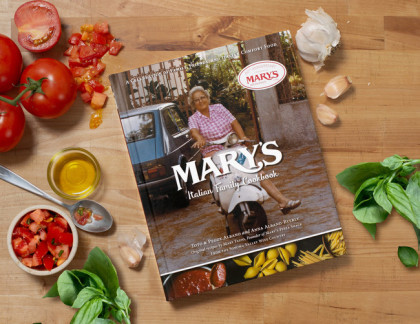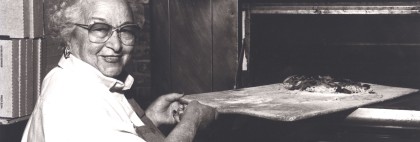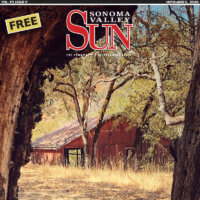Family Album, Italian Style
The story of Mary Fazio has a little of everything — even her meatball recipe
For over 60 years and four generations as a family business, Mary’s Pizza Shack has been a Sonoma Valley tradition, a wonderful homegrown (and homemade) success story. Mary Fazio actually did start out in a ‘shack’ — actually, a small cottage across the street from the current Boyes Hot Springs location. The new “Mary’s Italian Family Cookbook,” written by Toto & Peggy Albano (Mary’s son & daughter in-law) and Anna Albano–Byerly (Mary’s daughter), is packed with delightful family stories and personal photographs. The thick hardcover volume lives up to its to its subtitle, “A Celebration of Family, Friends and Italian Comfort Food.”

Here’s an excerpt.
Mary never wrote her methods down. She learned by watching and doing, and that’s how she taught everyone who worked in her kitchen. As her family and employees relate, they watched her, they did it over and over her way, and if they got it right, it tasted (almost) as good as hers.
Of course, at home, family members developed their own style. “The marinara tastes different at each granddaughter’s house,” says Marie about her sisters, all of whom learned from their grandmother, Mary. Peggy, in turn, had learned her husband Toto’s favorite recipes from Mary, her mother-in-law.
But Mary’s original recipes might have faded in time if not for Cully Williamson, who met Mary’s granddaughter Terri at college. After he and Terri married, Cully joined forces with Toto, his father-in-law, to expand the business and open a second location. For this, they needed recipes that could reproduce what Mary and her staff did by habit and instinct. “I had to get her in the kitchen and watch. I kept slowing her down, weighing this, measuring that,” recalls Cully, who carefully translated her handfuls and pinches into cups and teaspoons. Even though Mary was sixty-nine when the second restaurant opened in Cotati in 1982, a little farther than twenty miles from the original, she’d stop by every few days and head straight to the kitchen to check on the pasta sauces.
Pasta is the canvas on which Italian chefs paint. Sauces, then, are their colors, from bold marinara and hearty ragù to fragrant pesto and tangy citrus. Each pasta shape has its traditional sauce, one that clings in all of the right places. Of course, you can mix and match to suit your taste (and pantry), but most of these recipes stand by tradition for a very delicious reason: it works. Spaghetti goes with meatballs, linguine with seafood, gnocchi with meat sauce, and sturdy penne with a robust blend of sausage and mushrooms. Some customers could never decide on just one favorite; for them, Mary would serve a “half and half”—spaghetti and ravioli in one bowl.

Pizza was the heart of Mary’s original restaurant. The ingredients were simple, and at the time, in rural Sonoma County, pizza was still a novelty. At home, she made what she called “fugazza,” a Sicilian-style, focaccia-type pizza, with a thick yeast-leavened dough pressed into a rectangular baking pan and topped with anchovies and fresh tomatoes.
But she could see that commercial pizzerias were making thinner-crusted, round Neapolitan pies with tomato sauce, cheese, and an ever-growing variety of toppings. Luckily, Mary had an expert consultant on hand. Her brother-in-law Gigi, who had grown up in Naples, helped her develop the pizza dough recipe. Another expert was family friend Stanley Anastasio, who was from Ischia and had found fame running Victor’s Pizzeria on Polk Street in San Francisco. From Gigi, Stanley, and Stanley’s brother, Mary learned that the dough was the most important part of any pizza. Next came the sauce, followed by the mozzarella.

As Toto remembers it, the Anastasio brothers were also responsible for the name of Mary’s original restaurant. As they walked around the little cottage, she asked them what she should call it. “Mary, it’s a shack!” they exclaimed. “Call it Mary’s Pizza Shack.”
Where to find the cookbook



Be First to Comment